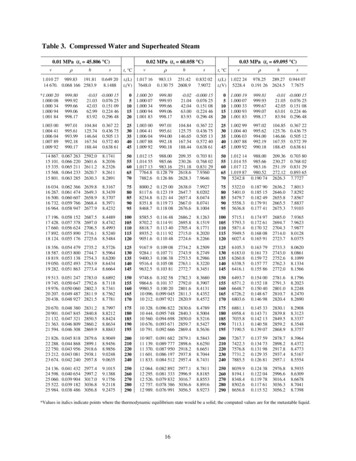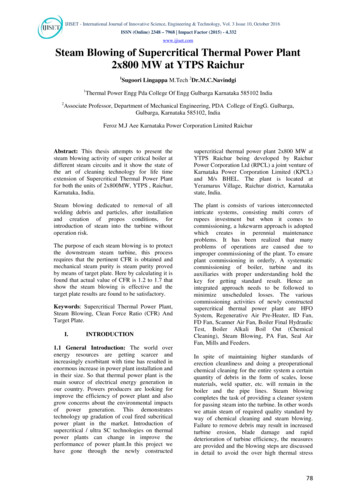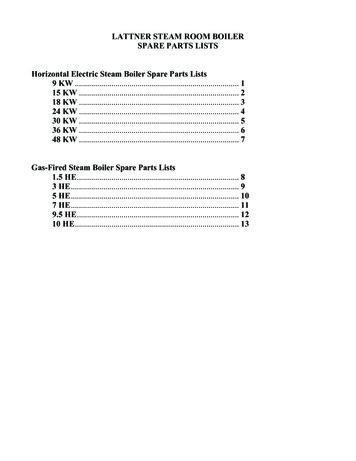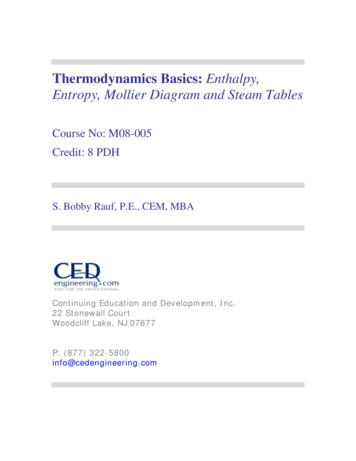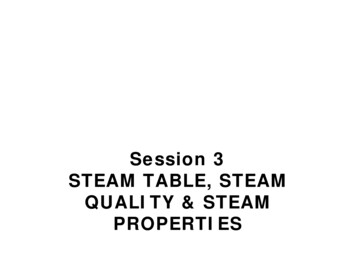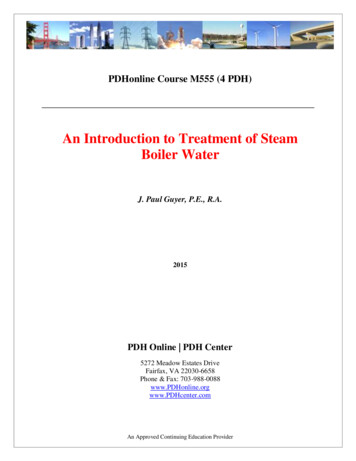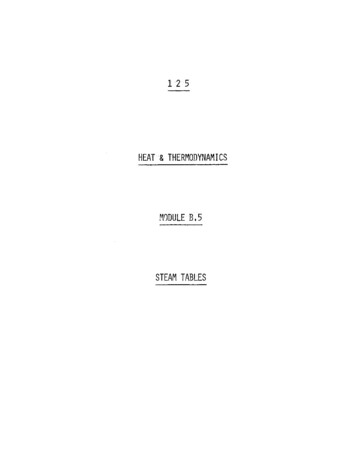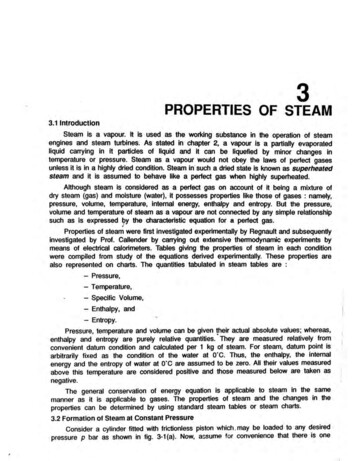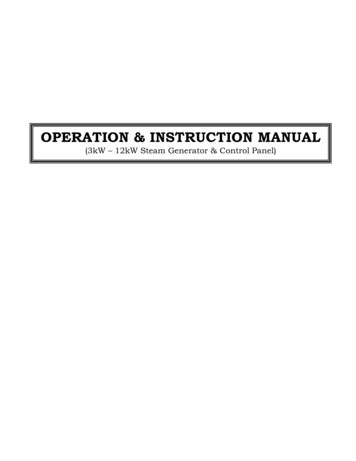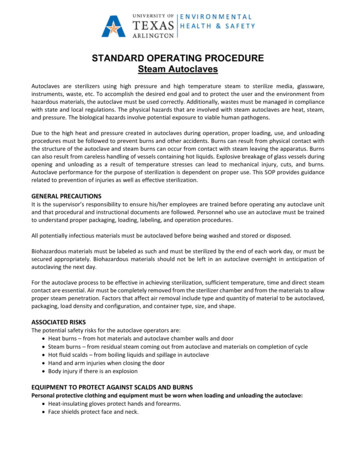
Transcription
STANDARD OPERATING PROCEDURESteam AutoclavesAutoclaves are sterilizers using high pressure and high temperature steam to sterilize media, glassware,instruments, waste, etc. To accomplish the desired end goal and to protect the user and the environment fromhazardous materials, the autoclave must be used correctly. Additionally, wastes must be managed in compliancewith state and local regulations. The physical hazards that are involved with steam autoclaves are heat, steam,and pressure. The biological hazards involve potential exposure to viable human pathogens.Due to the high heat and pressure created in autoclaves during operation, proper loading, use, and unloadingprocedures must be followed to prevent burns and other accidents. Burns can result from physical contact withthe structure of the autoclave and steam burns can occur from contact with steam leaving the apparatus. Burnscan also result from careless handling of vessels containing hot liquids. Explosive breakage of glass vessels duringopening and unloading as a result of temperature stresses can lead to mechanical injury, cuts, and burns.Autoclave performance for the purpose of sterilization is dependent on proper use. This SOP provides guidancerelated to prevention of injuries as well as effective sterilization.GENERAL PRECAUTIONSIt is the supervisor’s responsibility to ensure his/her employees are trained before operating any autoclave unitand that procedural and instructional documents are followed. Personnel who use an autoclave must be trainedto understand proper packaging, loading, labeling, and operation procedures.All potentially infectious materials must be autoclaved before being washed and stored or disposed.Biohazardous materials must be labeled as such and must be sterilized by the end of each work day, or must besecured appropriately. Biohazardous materials should not be left in an autoclave overnight in anticipation ofautoclaving the next day.For the autoclave process to be effective in achieving sterilization, sufficient temperature, time and direct steamcontact are essential. Air must be completely removed from the sterilizer chamber and from the materials to allowproper steam penetration. Factors that affect air removal include type and quantity of material to be autoclaved,packaging, load density and configuration, and container type, size, and shape.ASSOCIATED RISKSThe potential safety risks for the autoclave operators are: Heat burns – from hot materials and autoclave chamber walls and door Steam burns – from residual steam coming out from autoclave and materials on completion of cycle Hot fluid scalds – from boiling liquids and spillage in autoclave Hand and arm injuries when closing the door Body injury if there is an explosionEQUIPMENT TO PROTECT AGAINST SCALDS AND BURNSPersonal protective clothing and equipment must be worn when loading and unloading the autoclave: Heat-insulating gloves protect hands and forearms. Face shields protect face and neck.
Splash apron protects chest and legs. Closed-toed footwear protects feet.PREPARATION FOR AUTOCLAVING Ensure that the material is able to be autoclaved – Oils, waxes, some plastics, flammable materials, radioactivematerials, and samples containing solvents or substances that may emit toxic fumes should not be autoclaved. Glassware should be heat-resistant borosilicate (Pyrex or Kimax) and inspected for cracks prior to autoclaving. Plastics should be heat-resistant, for example, polycarbonate (PC), PTFE ("Teflon"), and polypropylene (PP)items. Prepare and package material suitably: Loose dry materials should be wrapped or bagged in steam-penetrable paper or loosely covered withaluminum foil. Wrapping too tightly will impede steam penetration, decreasing efficiency of the process. Containers of liquid should be a maximum volume of 2/3 filled. All containers should be covered by a loosened lid or steam-penetrable bung to prevent pressure buildupand avoid shattering of bottles during pressurization. Use plain, unmarked containers for items that are not hazardous. Items or baskets should be tagged with autoclave temperature tape. Place items in containers to secure and contain spills. Place containers of liquid, bags of agar plates, orother materials that may boil over or leak inside a secondary pan (must be autoclavable plastic or stainlesssteel container) in the autoclave. The pan must be large enough to contain a total spill of the contents.Open, shallow metal pans are more effective in conducting heat and allowing air removal than tall, plastictubs. Adding some water to the secondary pan will help to heat items more evenly.LOADING THE AUTOCLAVE Make sure the drain strainer in the bottom of the autoclave’s sterilizer chamber is clean before loading theautoclave. Use a cart to transfer items to be autoclaved. To avoid back injuries, push the cart up to the autoclave doorand gently slide the load into the autoclave. Never place autoclave bags or glassware in direct contact with the bottom of the autoclave. Place thesecondary pan containing the items to be sterilized on the shelf or rack of the autoclave. Do not overload the autoclave. It is important to leave sufficient room for thorough steam circulation. Do not mix loads of liquids with solids. Firmly lock autoclave door prior to starting the run to prevent sudden release of high-pressure steam. Make sure that you have selected the correct cycle before starting the autoclave (see below).OPERATING PARAMETERSThe parameters for the sterilization cycle will depend upon the amount and type of material. Usually 121 C at 15pounds-force per square inch (lbf/in2 or psi) for a minimum of 30 minutes is recommended. However, thetemperature and cycle time can be increased taking into consideration the size and type of load. Autoclavemanufacturers generally provide several pre-set cycle options which will vary in the pre-set sterilizationtemperature, sterilization time, and dry time. Gravity cycle – air removal from the autoclave chamber prior to the sterilization part is achieved by gravityair purge. A gravity cycle is appropriate for loads where air removal from porous materials or penetrationof steam into wrapped/packaged items is not required.
Vacuum cycle – air from the autoclave chamber prior to the sterilization part is achieved by pulsing betweenpressure and vacuum. Vacuum cycle is suitable for wrapped or difficult to penetrate items. Liquids cycle – gravity air purge removes air from the chamber as in gravity cycle. Pulling a deep vacuum isnot done since liquids to be autoclaved would be drawn out of their vessels.The exact operating procedure for each model of autoclave will differ. The user should develop an SOP to describeproper steps to operate the autoclave.UNLOADING THE AUTOCLAVEAfter the run is completed, check the pressure gauge to ensure that the pressure in the chamber is “0”. If pressureis not released, do not open the door. Inform your PI / supervisor about the malfunction. Before opening the door put on your eye protection and heat-resistant gloves or mitts. Be sure to wearclosed-toed shoes (hot condensate may drip from the door). Rubber aprons in addition to rubber sleeveprotectors are advisable. Carefully crack door open to release residual steam and allow pressure within liquids and containers tonormalize. Wait a full five minutes if the autoclave load contains only dry glassware, and no less than tenminutes when you are autoclaving liquids before removing the items. Use caution when removing liquids, molten agar, etc. Liquids, especially large volumes, may continueboiling for some time after autoclaving. Do not agitate containers of super-heated liquid or remove capsbefore unloading to avoid getting splashed with scalding liquid. Slide a cart to the opening of the autoclave and pull the autoclave secondary container onto the cart fortransport. Place the cart in a low traffic area while additional cooling occurs. Let the glassware cool for 15 minutes and liquid loads for a full hour before touching the items withungloved hands. NOTE: If a faulty condition exists (e.g., sterilizer did not finish the cycle, or water leaks out when the door isunlocked), inform the person responsible for contacting autoclave service technician.AUTOCLAVING BIOHAZARDOUS WASTE MATERIALS INSIDE HEAT RESISTANT AUTOCLAVABLE BAGS Use heat resistant autoclavable bags labeled “biohazard” (usually red or orange) for waste materials thatcontain or may be contaminated with potentially infectious agents. Biohazard waste bags should be stored in rigid leak-proof secondary containment pans. Waste should be stored inside the autoclave room and not in the hallways. Do not double bag waste or tightly seal bags as this will impede steam penetration. Avoid compressing bags. This may create aerosols. It is advisable to add some water to bags of solid wastes (the water will vaporize into steam that will driveout residual air once sterilization temperature has been reached inside the bag). Do not put sharp objects such as broken glassware into an autoclave bag. Add Steam Chemical Integrator inside each biohazard waste bag (attach the Steam Chemical Integrator tothe bag using e.g. autoclave temperature tape) to assure steam autoclave kill cycle sterilization (see SOP:Steam Chemical Integrators / Sterilization Assurance / Steam Autoclave Kill Cycle) Label the autoclavable bag with a “biohazard” symbol on it with commercially available autoclavetemperature tape that changes color, e.g., visible black stripes or the word “AUTOCLAVED” appear oncesterilizing temperature has been reached. Autoclave temperature tape only tells that desired temperaturewas reached not time nor pressure. Apply this tape across the “biohazard” symbol on the bag beforeautoclaving. Do not throw away any biohazard bags without covering all biohazard symbols. Use secondary containment pan under the bag to catch any leaks that may occur during autoclaving.
Autoclave 50 to 60 minutes, at temperature and pressure of 121o C (250o F) and 15 psi. When cycle is finished, inspect autoclave temperature tape and visually check autoclaved bags. Bags should be left to cool for several minutes before removing from autoclave. Once cool, remove theSteam Chemical Integrator from the autoclave bag and interpret the results to ensure that the autoclavewas working correctly (see SOP: Steam Chemical Integrators / Sterilization Assurance / Steam Autoclave KillCycle). If test indicates a successful sterilization, securely close biohazard bag with tape or tie wrap, attach alabel to autoclaved waste bag that states: “Treated in accordance with the provisions of 25 TAC § 1.136(a)”and place bag inside another opaque bag (black, green, etc.) to be placed in regular trash. Parameter monitoring (pressure, time and temperature) is important to ensure efficacy of an autoclave! Do not pour melted agar down the drain as it will congeal and clog the plumbing! Biohazardous waste should not be left for “someone else” to autoclave!RECORDKEEPING FOR TREATMENT OF BIOHAZARDOUS WASTE Document the treatment of each load of biohazardous waste on the Autoclave Waste Treatment Log (COEHS-F501) provided by Environmental Health and Safety Office (EH&S) which lists the date of treatment,the amount of waste treated, the method/conditions of treatment, the printed name/initials includingcontact info of the person autoclaving the waste, and result of Steam Chemical Integrator test. Keep charts or printout strips (if autoclave is equipped with these types of documenting options) with thelog sheets as documentation of the autoclave operation.REPAIRS / MAINTENANCE No person shall operate an autoclave unless it has been inspected by a qualified inspector and a certificateof inspection has been issued. A current inspection certificate must be posted near the autoclave. Users are not to make repairs. Autoclaves shall be maintained and repaired by qualified persons. If the autoclave does not operate exactly as expected, a notice shall be placed on the autoclave indicatingthat it is not to be used until the problem is diagnosed and corrected. Inform the person responsible forcontacting autoclave service technician. Record the problem in autoclave log book. When maintenance work or repairs are needed, the user must provide a safe work environment for theservice technician. Remove all items from the sterilizer chamber, clean any spills or leaks inside the chamber,remove untreated biohazardous materials from the vicinity, etc.INCIDENT RESPONSE If any injury occurs seek first aid or, if necessary, seek medical assistance by dialing UTA Police Dispatch at817-272-3003. If clothing is soaked in hot water/steam, remove clothing and cool the injured part in cool water. Place a notice on the autoclave indicating that it is not to be used until the cause of the incident isdetermined, procedures enacted to prevent future incidents, and the autoclave is deemed safe foroperation. All other non-emergency incidents are to be reported to EH&S at 817-272-2185.SPILL CLEAN-UP Spills may occur from a boil-over or breakage of containers. No operation of the autoclave is allowed until the spill is cleaned up.
The operator is responsible for clean-up of spills. The spilled material can be contained using materials fromthe spill kit to absorb or contain the spill. Wait until the autoclave and materials have cooled to room temperature before starting the cleanup insidethe autoclave. Review the Safety Data Sheet(s) (SDS) of the spilled material(s), if appropriate, to determine what protectiveequipment, spill cleanup, and disposal protocols are necessary. Clean the equipment and work area in order to collect and remove all spilled materials. Dispose of the wastefollowing the protocol appropriate for the material. If materials have been intermingled, follow the cleanupand disposal protocol for the most hazardous component of the mixture. Cracked clean glassware must be disposed of properly in the “broken glass” disposal container provided byCustodial / EH&S. Record the spill and cleanup procedure in autoclave log book. Inform EH&S so that the spill kit can be refurbished.AUTOCLAVE PERFORMANCE CHECKSEH&S will check the autoclave performance for waste treatment (SOP: Performance Verification of SteamAutoclave Kill Cycle). The efficacy is monitored with biological indicators (ampoules of Geobacillusstearothermophilus spores) at an appropriate frequency to ensure that the sterilization parameters are effectivein treating biohazardous waste.The documentation of the waste sterilization treatments/results of any verification tests using biologicalindicators are kept in storage by EH&S.TRAININGThe training course “On-Site Biohazardous Waste Management: Autoclaving” (BIOL300) is available on the EH&STraining Management website: https://uta-ehs.org.REFERENCES1. Texas Administrative Code, Title 25 (Health Services), Part 1 (Department of State health Services), Chapter 1(Miscellaneous Provisions),2. Texas Administrative Code, Title 30 (Environmental Quality), Part 1 (Texas Commission on EnvironmentalQuality, Chapter 330 (Municipal Solid Waste).3. Biosafety in Microbiological and Biomedical Laboratories, U.S. Department of Health and Human Services,Centers for Disease Control and Prevention/National Institutes of Health, 6th edition, revised 2020.4. UTA Biosafety Manual – EH&S, the University of Texas at Arlington, August, 2013 (revised 8/23/2019).5. Laboratory Safety Manual (Chemical Hygiene Plan) – The University of Texas at Arlington, Environmental Healthand Safety, October, 2011 (revised May 2019).Should you have any questions regarding autoclaving operations and procedures, please do not hesitate to contactthe Biological Safety Specialist at EH&S, 817-272-2185. Thank you for your cooperation.Revised 6/3/2021
Due to the high heat and pressure created in autoclaves during operation, proper loading, use, and unloading procedures must be followed to prevent burns and other accidents. Burns can result from physical contact with the structure of the autoclave and steam burns can occur from contact with steam leaving the apparatus. Burns can also result from careless handling of ve ssels containing hot .

